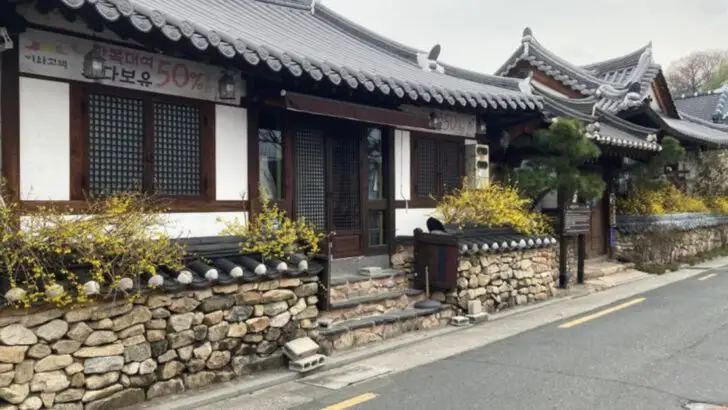Silence still reigns in these corners of Asia. No tour buses. No crowds chasing selfies. Just quiet streets, distant temple bells, and the scent of something delicious cooking in a family kitchen nearby. While much of the continent hums with motion, these peaceful towns and villages have somehow hit pause. Life here doesn’t sprint—it strolls. You won’t find glitzy resorts or flashing signs. What you will find are mountains reflected in still lakes, wooden homes worn smooth by time, and locals who’ll greet you like an old friend. If you’ve ever dreamed of disappearing into the kind of place where nature whispers and time stretches wide—start here. Because while the world races forward, these rare havens remember how to stand still.
Shirakawa-go, Japan
Shirakawa-go, in Japan’s Gifu Prefecture, enchants with its gassho-zukuri farmhouses, iconic for their steep thatched roofs. These structures are designed to withstand the heavy snowfalls of the region.
While the village does attract visitors, it retains a tranquil aura, especially during early mornings or off-peak months. Locals still inhabit many of the historic houses, maintaining a deep connection with their ancestry.
Surrounded by rice fields, the village offers a glimpse into traditional Japanese rural life, unblemished by modern tourism. A UNESCO World Heritage site, it stands as a testament to Japan’s cultural heritage.
Mae Kampong, Thailand
Mae Kampong, a picturesque mountain village near Chiang Mai, Thailand, invites with its serene beauty. Nestled amidst verdant forests and cascading waterfalls, it is home to under 1,000 residents.
The village is known for its warm homestays, where visitors can engage in tea farming and enjoy peaceful walks through narrow paths.
Guests have the unique opportunity to join locals in tea picking or assist in preparing meals within family kitchens. This immersion offers a genuine insight into Thai village life, away from the tourist trails. Mae Kampong is a haven of tranquility.
Phong Nha, Vietnam
Phong Nha, Vietnam, may be famous for its massive caves, but the town itself remains a laid-back haven. Guesthouses and quaint cafés line the serene riverside, where cows often graze.
The town preserves its relaxed charm, with locals often biking through the picturesque rice fields. Visitors are greeted with warmth and curiosity rather than typical tourist sales pitches.
The ambiance is unhurried, inviting travelers to slow down and appreciate the natural surroundings and friendly community. Phong Nha offers a refreshing escape from the usual tourist circuits.
Luang Prabang, Laos
Tucked between majestic mountains and the confluence of the Nam Khan and Mekong rivers, Luang Prabang is a tranquil town that exudes a gentle charm. Known for its well-preserved French colonial architecture and lush surroundings, it feels like stepping back in time.
The town is dotted with ornate Buddhist temples, where the rhythm of daily alms-giving rituals adds to its spiritual aura. The slow pace of life and rich cultural tapestry make Luang Prabang an alluring destination for those seeking peace and reflection.
A fun fact: Luang Prabang is a UNESCO World Heritage Site, recognized for its unique blend of urban and rural developments, cultural landmarks, and natural beauty.
Ziro, India (Arunachal Pradesh)
In the lush landscapes of Arunachal Pradesh lies Ziro, home to the Apatani tribe. Known for its expansive rice paddies and pine-covered hills, it offers an authentic cultural experience.
While famous for its music festival, Ziro maintains its calm for most of the year. Villagers adhere to traditional farming methods, and facial tattoos remain a cultural hallmark.
Visitors can explore the valley and engage with the local community, gaining insight into a unique way of life. Ziro is a peaceful retreat into India’s rich tribal heritage and natural beauty.
Kejimane, Indonesia (Flores Island)
Kejimane, on Flores Island, Indonesia, captivates with its stunning volcanic backdrop and serene shores. Nestled near Mount Inerie, it boasts picturesque black-sand beaches.
This coastal village sees fewer travelers than nearby tourist hotspots like Komodo, making it a tranquil paradise. The sound of waves and bird calls dominate over car horns or bustling tour groups.
Kejimane is a place where nature reigns, offering visitors a chance to unwind in its natural beauty. It’s an idyllic escape for those seeking peace and connection with the landscape.
Bukit Lawang, Indonesia (Sumatra)
Bukit Lawang in Sumatra, Indonesia, is a village where wildlife and tranquility coexist. Known for its proximity to orangutans, the village itself offers a laid-back atmosphere.
Small wooden homes line the river, and while visitors often trek into the jungle for wildlife encounters, the evenings remain calm.
Electricity can be sporadic, adding to the charm as locals gather with guitars and stories around candlelight. This village provides a unique blend of adventure and peace, inviting exploration of both its natural and cultural treasures.
Tsum Valley, Nepal
In the remote Himalayas, Tsum Valley, Nepal, remains mostly untouched by modernity. Recently opened to outsiders, it retains a sense of mystery and tranquility.
Life here is shaped by monasteries, stone houses, and trails used by yaks. Pilgrims often walk barefoot along these rugged paths.
Without roads or cars, the valley offers a glimpse into a world where simplicity and spirituality guide daily life. It’s a sanctuary for those seeking solitude and a deep connection with Tibetan Buddhist culture and nature’s grandeur.
Kurama, Japan
Just outside Kyoto, Kurama feels like a world apart with its rich natural and spiritual landscapes. Cedar forests frame this village, known for its mountainside temple and natural hot springs.
Even with its proximity to a major city, Kurama maintains a quiet serenity. A single-track train adds to the slow-travel experience, winding up to the village.
Visitors find an escape in Kurama’s tranquil hot springs and historic paths, offering a perfect blend of relaxation and cultural exploration. It is a place where tradition meets nature beautifully.
Khimsar, India (Rajasthan)
Khimsar, in Rajasthan, India, offers a serene desert experience away from crowded tourist towns. Known for its historic fort, the village captures the essence of desert life.
Unlike bustling counterparts like Jaisalmer, Khimsar is smaller and more intimate. Camel carts leisurely roll through the village, painting a picture of timelessness.
Sunset over the sand dunes is a tranquil spectacle, free from large crowds. Khimsar invites visitors to experience the simple beauty and historical richness of Rajasthan’s desert heritage.
Nako, India
Nestled in the remote Kinnaur district of Himachal Pradesh, Nako offers a serene escape with its traditional stone houses and lush terraced fields. This picturesque village, surrounded by majestic mountains, provides a glimpse into the simple life of the local community.
The tranquil atmosphere is perfect for those looking to unwind and connect with nature. Visitors can explore the ancient Nako Monastery, which adds a spiritual touch to the experience.
With its vibrant culture and breathtaking views, Nako remains a hidden treasure, untouched by the hustle of modern tourism.
Hahoe Folk Village, South Korea
Nestled along the banks of the Nakdong River, Hahoe Folk Village provides a glimpse into Korea’s historical past. This charming village is home to well-preserved Hanok houses, which represent the traditional Korean architectural style.
The village is famous for its mask dance drama, a cultural spectacle that has been passed down through generations. Visitors often find themselves transported into another era, captivated by the beauty and tranquility of this cultural gem.
Surprisingly, Hahoe Folk Village is part of the Andong region, known for its rich history in Confucianism and traditional ceremonies, preserving an age-old way of life.
Bai Xep, Vietnam
Tucked away on the coast of central Vietnam, Bai Xep is a charming fishing village where time seems to stand still. The colorful fishing boats dotting the shore tell tales of the sea and the lives of the villagers.
With the waves gently lapping at the sandy beaches, it offers an idyllic setting for relaxation.
Bai Xep is not just about scenic beauty; it is a dive into the rich tapestry of Vietnamese culture and hospitality. Unspoiled by commercial tourism, it remains a genuine slice of Vietnamese life.
Savsat, Turkey
In the northeastern corner of Turkey, Savsat is a village steeped in natural beauty and history. Traditional stone houses stand surrounded by lush forests and rolling hills, painting a scene of tranquility.
The crisp mountain air is invigorating, and the landscape is a haven for nature lovers.
Savsat’s residents are known for their warmth and hospitality, often inviting visitors to partake in local customs and cuisine. This village is a perfect blend of nature and tradition, providing a peaceful escape from the modern world.
Yen Minh, Vietnam
Yen Minh, situated in Vietnam’s Ha Giang Province, is a hidden gem nestled among mist-covered mountains. Its remote location and terraced fields make it a picturesque destination for those seeking adventure and peace.
The town is home to diverse ethnic minority communities, each with unique customs and traditions.
Visitors can immerse themselves in the local culture, exploring vibrant markets and traditional homes. Yen Minh offers an authentic experience of Vietnam’s highlands, untouched by the commercialization of tourism, and promises a truly memorable visit.

